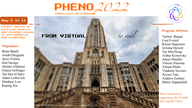Speaker
Description
We propose a new mechanism where a multi-component dark sector generates the observed dark matter abundance and baryon asymmetry and thus addresses the coincidence between the two. The thermal freeze-out of dark matter annihilating into meta-stable dark partners sets the dark matter relic abundance while providing the out-of-equilibrium condition for baryogenesis. The meta-stable state triggers baryon asymmetry production by its decay well after the freeze-out and potentially induces a period of early matter domination before its decay. The dark matter and baryon abundances are related through number conservation within the dark sector (cogenesis). The ``coincidence" is a natural outcome with GeV- to TeV-scale symmetric dark matter and the dark sector's interactions with the Standard Model quarks. We present a UV-complete model and explore its phenomenological predictions, including dark matter direct detection signals, LHC signatures of new massive particles with color charges and long-lived particles with displaced vertices, dark matter-induced nucleon conversions, (exotic) dark matter indirect detection signals, and effects on the cosmological matter power spectrum. As a side result, we provide a novel analytical treatment for dark sector freeze-out, which may prove useful in the study of related scenarios.

